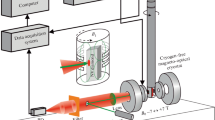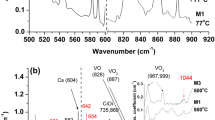Abstract
Single-crystal W-band electron paramagnetic resonance (EPR) spectra of an electron-irradiated quartz, measured at room temperature, 110 and 77 K, disclose three previously reported hole centers (#1, G and an ozonide radical). The W-band EPR spectra of these three centers clearly resolve six magnetically nonequivalent sites each, whereas previous X- and Q-band EPR studies reported Centers #1 and the ozonide radical to consist of only three symmetry-related components and interpreted them to reside on twofold symmetry axes in the quartz structure. The calculated g matrices of Center #1 and the ozonide radical show that deviations from twofold symmetry axes are <10°, which are probably attributable to distortion related to neighboring charge compensating ions. The W-band EPR spectra of Center G not only result in improved g matrices but also allow quantitative determination of the nuclear hyperfine (A) and quadrupole (P) matrices of its 27Al hyperfine structure that was incompletely resolved before. In particular, the g-maximum and g-minimum principal axes of Center G are approximately along two pairs of O–O edges of the SiO4 tetrahedron, while the unique A principal axis is approximately along a Si–Si direction. These new spin-Hamiltonian parameters suggest that Center G most likely involves trapping of a hole between two oxygen atoms related to a silicon vacancy and stabilized by an Al3+ ion in the neighboring tetrahedron (hence an O n−2 –Al3+ defect, where n is either 1 or 3).





Similar content being viewed by others
References
Andrews L, Burkholder TR, Yustein JT (1992) Reactions of pulsed-laser evaporated aluminum atom with oxygen. Infrared spectra of the reaction products in solid argon. J Chem Phys 96:10182–10189
Archibong EF, St-Amant A (1998) The cyclic MO2 (M=Al, Ga) systems: CCSD(T) and DFT studies of their structures, harmonic vibrational frequencies and dissociation energies. Chem Phys Lett 284:331–338
Azzoni CB, Meinardi F, Paleari A (1994) Trapped-hole centers in neutron-irradiated synthetic quartz. Phys Rev B49:9182–9185
Bednarek J, Schlick S (1991) Stability of radical intermediate in microscopically heterogeneous media. Photolysis of water adsorped on silica gel studied by ESR and DSC. J Phys Chem 95:9940–9944
Bershov LV, Marfunin AS, Speranskii AV (1978) The new stable electronic center in quartz. Izv Acad Nauk SSSR Ser Geol 1978(11):106–116 (in Russian)
Bershov LV, Marfunin AS, Speranskii AV (1981) Types of radiation centers in vein quartz of some gold-bearing deposits. Geol Rud Mestor 23:80–86 (in Russian)
Bershov LV, Martirosyan VO, Marfunin AS, et al (1971) The yttrium-stabilised electron-hole centers in anhydrite. Phys Stat Sol B44:505–512
Bill H (1969) Investigation of colour centres in alcaline earth flourides. Helv Phys Acta 42:771–797
Bossoli RB, Welsh TJ, Gilliam OR, et al (1979) Trapped-hole centers associated with trivalent cations in tetragonal GeO2. Phys Rev B19:4376–4381
Botis SM, Nokhrin S, Pan Y, et al (2005) Natural radiation-induced damage in quartz. I. Correlations between cathodoluminescence colors and paramagnetic defects. Can Mineral 43:1565–1680
Botis SM, Pan Y, Bonli T, et al (2006) Natural radiation-induced damage in quartz. II. Distributions and implications for uranium mineralization in the Athabasca basin. Can Mineral 44:1569–1585
Botis SM, Pan Y, Nokhrin S, Nilges MJ (2007) Natural radiation-induced damage in quartz. III. A new ozonide center. Can Mineral (accepted with revision)
Carbonaro CM, Fiorentini V, Berardini F (2001) Proof of the thermodynamical stability of the E′ center in SiO2. Phys Rev Lett 86:3064–3067
Castner T, Känzig W (1957) The electronic structure of V-centers. J Chem Phys Solids 3:178–195
Clemmer DE, Dalleska NF, Armentrout PB (1992) Gas-phase thermochemistry of the group 3 dioxides: ScO2, YO2 and LaO2. Chem Phys Lett 190:259–265
Coronado JM, Maira AJ, Mathinez-Arias A, et al (2002) ESR study of the radicals formed upon UV irradiation of ceria-based photocatalysts. J Photochem Photobiol A: Chem 150:213–221
Cox RT (1976) ESR of an S=2 centre in amethyst quartz and its possible identification as the d4 ion Fe4+. J Phys C: Solid State Phys 9:3355–3361
Friebele EJ, Griscom DL, Stapelbroek M, et al (1979) Fundamental defect centers in glass: the peroxy radical in irradiated, high-purity, fused silica. Phys Rev Lett 42:1346–1349
Garrison EG, Rowlett RM, Cowan DL, et al (1981) ESR dating of ancient flints. Nature 290:44–45
Gonzales JM, King RA, Schaefer HF (2000) Analyses of the ScO− and ScO −2 photoelectron spectra. J Chem Phys 113:567–576
Götze J, Plötze M, Trautmann T (2005) Structure and luminescence characteristics of quartz from pegmatites. Am Mineral 90:13–21
Griscom DL, Friebele EJ (1981) Fundamental defect centers in glass: 29Si hyperfine structure of the non-bridging oxygen hole center and the peroxy radical in SiO2. Phys Rev B 24:4896–4898
Hochstrasser G, Antonini JF, Peyches I (1969) ESR of O −2 center on SiO2 surface. In: Somorjai CA (ed) The structure and chemistry of solid surfaces. Wiley, New York
Howarth DF, Mombourquette MJ, Weil JA (1997) The magnetic properties of the oxygen-hole aluminum centres in crystalline SiO2. V. 17O-enirhced [AlO4/Li]+ and dynamics thereof. Can J Phys 75:99–115
Ikeya M (1993) New applications of electron paramagnetic resonance: ESR dating, dosimetry, and spectroscopy. World Scientific, Singapore
Jani MG, Bossoli RB, Halliburton LE (1983) Further characterization of the E 1′ centre in crystalline SiO2. Phys Rev B 27:2285–2293
Jette AN, Gilbert TL, Das TP (1969) Theory of the self-trapped hole in the alkali halides. Phys Rev 184:884–894
Känzig W, Cohen MH (1959) Paramagnetic resonance of oxygen in alkali halides. Phys Rev Lett 3:509–511
Kappers LA, Gilliam OR, Stapelbroek M (1978) Points defects in particle-irradiated crystals of tetragonal GeO2. Phys Rev B17:4199–4206
Lagendijk A, Glasbeek M, Van Voorst JDW (1973) Paramagnetic oxygen centres in SrTiO3 induced by light. Chem Phys Lett 20:92–95
Le Page Y, Calvert LD, Gabe EJ (1980) Parameter variation in low-quartz between 94 and 298K. J Phys Chem Solids 41:721–725
Lunsford JH (1973) ESR of adsorbed oxygen species. Cat Rev 8:135–156
Mackey JH, Boss JW, Wood DE (1970) EPR Study of substitutional–aluminum-related hole centers in synthetic α-quartz. J Magn Res 3:44–54
Marfunin AS (1979) Spectroscopy, luminescence and radiation centers in minerals. Springer, Berlin
Maschmeyer D, Lehmann G (1983) New hole centers in natural quartz. Phys Chem Miner 10:84–88
Mashkovtsev RI, Shcherbakova MYa, solntsev vp (1978) EPR of radiation hole centers in α-quartz. Tr Inst Geol Geofiz, Akad Nauk SSSR, Sib Otd 385:78–86 (in Russian)
Mombourquette MJ, Weil JA (1986) Structure determination of the AlO4 hole centres in α-quartz by EPR and SCF MO. J Magn Res 66:105–117
Mombourquette MJ, Weil JA, McGavin DG (1996) EPR-NMR Users’ manual. Department of Chemistry, University of Saskatchewan, Saskatoon, SK, Canada
Morton JR, Preston KF (1978) Atomic parameters for paramagnetic resonance data. J Magn Res 30:577–582
Murata C, Yoshida H, Kumagai J, Hattori T (2003) Active sites and active oxygen species for photocatalytic epoxidation of propene by molecular oxygen over TiO2-SiO2 binary oxides. J Phys Chem B107:4364–4373
Nilges MJ, Smirnov AI, Clarkson RB, et al (1999) Electron paramagnetic resonance W band spectrometer with a low-noise amplifier. Appl Magn Reson 16:167–183
Ogoh K, Yamanaka C, Ikeya M, et al (1996) Two-center model for radiation induced aluminum hole center in stishovite. J Phys Chem Solids 57:85–88
Pak MV, Gordon MS (2003) Potential energy surfaces of Al+O2 reactions. J Chem Phys 118:4471–4476
Pan Y, Chen N, Weil JA, et al (2003) Electron paramagnetic resonance spectroscopic study of synthetic fluorapatite. Part III. Structural characterization of sub-ppm-level Gd and Mn in minerals at W-band frequency. Am Mineral 87:1333–1341
Pan Y, Botis S, Nokhrin S (2006) Application of natural radiation-induced paramagnetic defects in quartz to exploration in sedimentary basins. J China U Geosci 17:258–271
Priest V, Cowan DL, Yasar H, et al (1991) ESR, optical absorption, and luminescence studies of the peroxy-radical defect in topaz. Phys Rev B44:9877–9882
Purcell T, Weeks RA (1969) Radiation-induced paramagnetic states of some intrinsic defects in GeO2 glasses and crystals. Phys Chem Glasses 10:198–208
Requardt A, Lehmann G (1985) An O 3−2 radiation defect in AlPO4 and GaPO4. J Phys Chem Solids 46:107–112
Rossman GR (1994) Colored varieties of the silica minerals. Rev Mineral 29:433–467
Samoloivich MI, Tsinober LI, Kreiskop VN (1970) Features of smoky color of natural quartz crystals: morions. Sov Phys Crystallogr 15:438–440
Schnadt R, Räuber A (1971) Motional effects in the trapped-hole center in smoky quartz. Solid State Commun 9:159–161
Schmidt MW, Baldridge KK, Boatz JA, et al (1993) General atomic and molecular electronic structure system. J Comput Chem 14:1347–1363
Schweizer S, Spaeth J-M (1999) New oxygen hole centers in the x-ray storage phosphor BaBrF. J Phys Condens Matter 11:1723–1733
Serebrennikov LV, Osin SB, Mal’tsev AA (1982) Infrared spectra of the products of reaction of aluminum, gallium, indium, and thallium with oxygen in an argon matrix. Estimation of the fundamentals, ν3, in cyclic superoxides of Group III metals. J Mol Struct 81:25–33
Solntsev VP, Shcherbakova MYa, Schastnev PV (1973) EPR study of structural defects in CaWO4. Zh Strukt Chim 14:222–229
Walsby CJ, Lees NS, Claridge RFC, et al (2003) The magnetic properties of oxygen-hole aluminum centres in crystalline SiO2. VI: a stable AlO4/Li centre. Can J Phys 81:583–598
Wagner GR, Murphy J (1972) Paramagnetic hole centers in CeO2. Phys Rev B6:1638–1644
Wang KM, Lunsford JH (1971) An electron paramagnetic resonance study of Y-type zeolites. III. O −2 on AlHY, ScY, and LaY Zeolites. J Phys Chem 76:1165–1168
Weil JA (1984) A review of electron spin resonance and its applications to the study of paramagnetic defects in crystalline quartz. Phys Chem Miner 10:149–165
Zhao Q, Wang X, Cai T (2004) The study of surface properties of ZrO2. Appl Surf Sci 225:7–13
Acknowledgments
We wish to thank the Natural Science and Engineering Research Council (NSERC) of Canada for financial support of this study, and two reviewers and Dr. Milan Rieder for helpful comments and suggestions.
Author information
Authors and Affiliations
Corresponding author
Rights and permissions
About this article
Cite this article
Nilges, M.J., Pan, Y. & Mashkovtsev, R.I. Radiation-damage-induced defects in quartz. I. Single-crystal W-band EPR study of hole centers in an electron-irradiated quartz. Phys Chem Minerals 35, 103–115 (2008). https://doi.org/10.1007/s00269-007-0203-5
Received:
Accepted:
Published:
Issue Date:
DOI: https://doi.org/10.1007/s00269-007-0203-5




